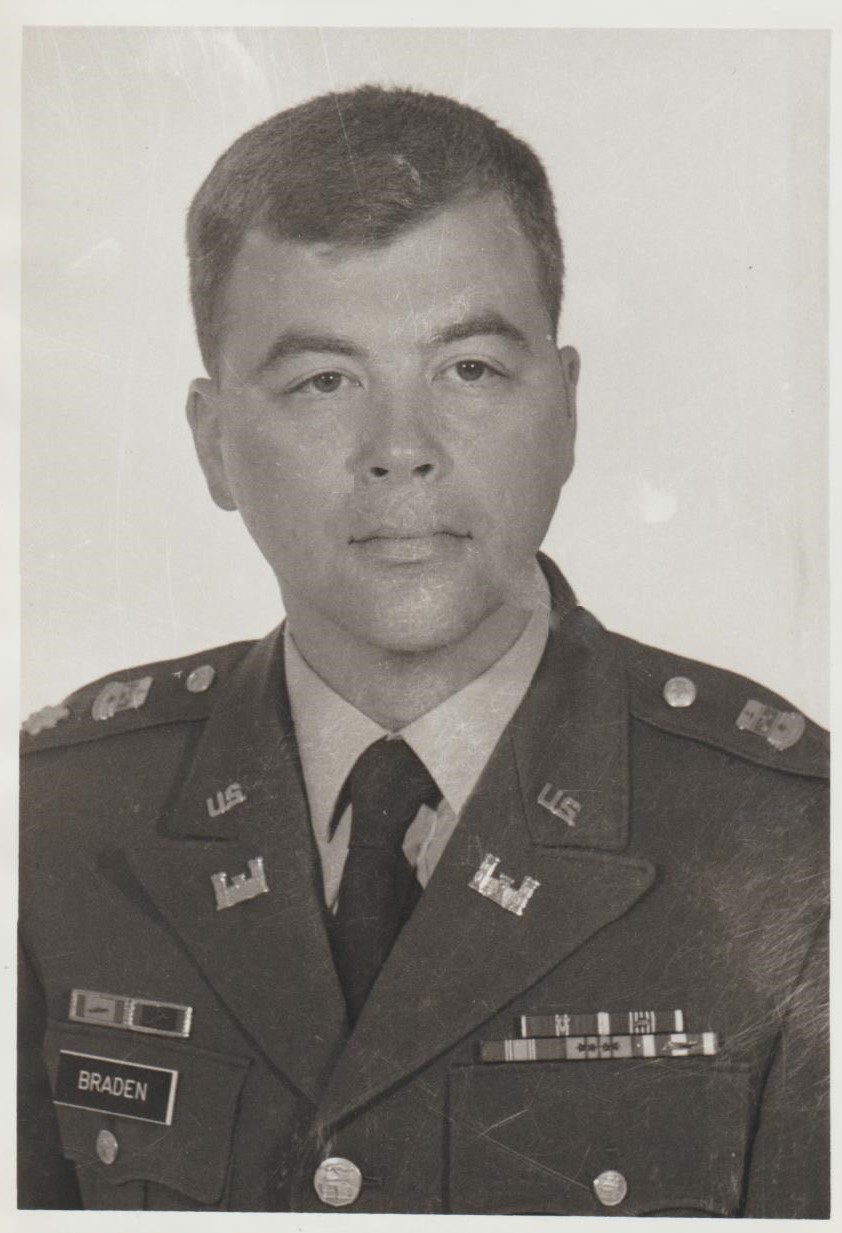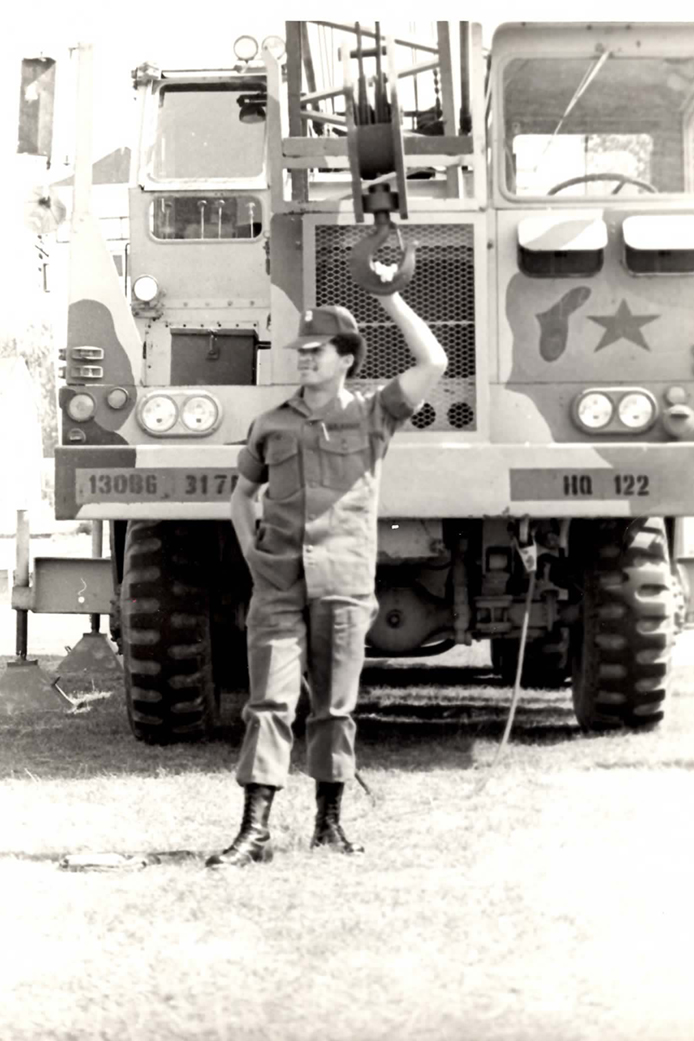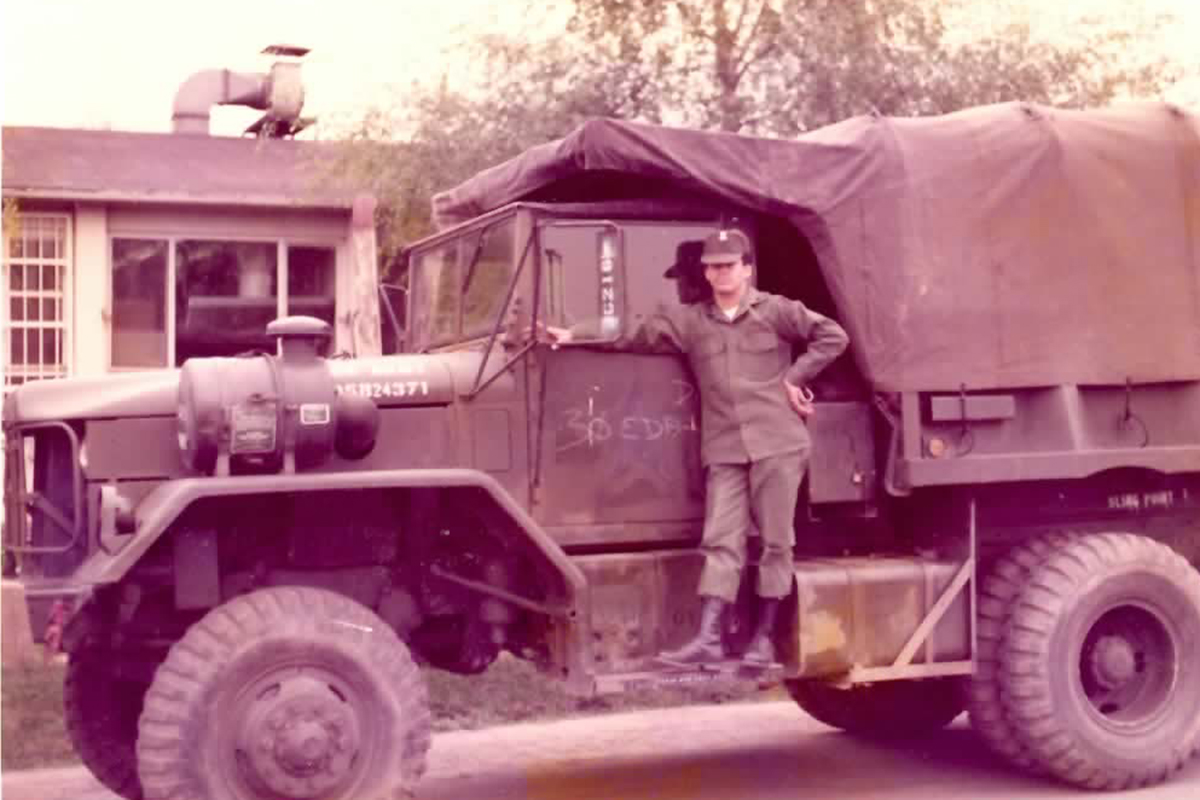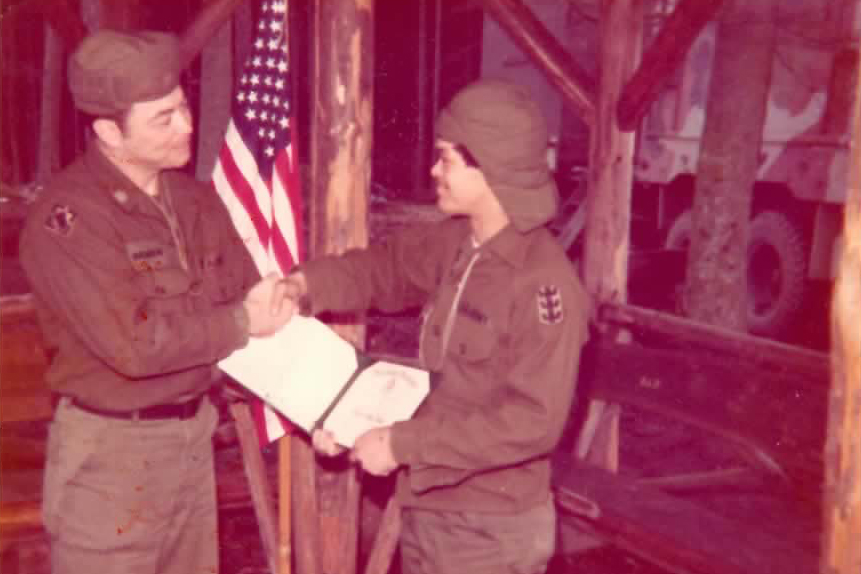
| These are some personal notes that describe some of my memories and opinions of the organizations that I served with in an Army career that spanned nearly 30 years. If you find this site by accident through a search engine you are welcome to contact me and share your thoughts. Thanks. My e-mail address is BradenClan@ gmail.com. |
317th Engineer Battalion (Combat)
Eschborn (Near Frankfurt), Germany
1976-1978
The 317th Engineer Battalion (Combat) was located in Eschborn, Germany, on the outskirts of Frankfurt. The battalion was part of the 130th Engineer Brigade, and it supported the 3rd Armored Division.
Bonnie and I moved from our third floor government housing in Mark Twain Village, Heidelberg, to our third floor government quarters in the FranKfurt Housing area. Bonnie stayed active by playing with the kids, by opening a nursery school, and by serving as the Elementary School PTA President.
I was the S-3 Operations Officer, and the areas of training and war planning came under me. The S-3 also provided oversight of the Communications Section and the S-2 Intelligence Section, as the S-2 was normally a First Lieutenant.
The battalion was at a low when I arrived, and a failed readiness test shortly after my arrival cost the battalion commander his job. A number of factors came into play in this sad state of affairs, including the 317th being a non-divisional battalion too close to the V Corps flagpole in Frankfurt.
The new commander was Lieutenant Colonel Fred Butler, and he soon brought in Major Larry Bonine as the XO. Butler, Bonine, and Braden did a lot of sweating over the next two years, but we also had some of the best times of my career. Fred's steady date, Rosemarie, later to be his wife; Larry’s wife Rosemary, and Bonnie formed a triple threat that kept us all hopping and happy with all kinds of fun activities. One of the things we did was dress up as the Puckers, where the ladies made coats that went around
Back to the battalion: Fred Butler had his work cut out for him; taking over a battalion on the bottom and doing some good with it. Oh, yes, 'there was no way to go but up' is a nice saying, but putting that into practice is something else. Fred did it. I admire him greatly. He was a practitioner of "management by walking around." He was all over the battalion area talking to soldiers, listening to soldiers, and showing them that he cared. He would come into staff meetings always knowing more than the staff because he was always "out there" sharing information. On a related matter, I fondly recall Fred - with a furrowed brow and a direct stare into everyone's face - saying at a staff meeting, "I envision the next two or three months as a period of intense activity, but after that we should have smooth, easy sailing." Super! We charged out do do good things for the Army and great things for the 317th. However, it turned out that Fred was able to look us convincingly and sincerely in the eye every two or three months and give the same speech. And we continued to charge out the door.
Larry Bonine was also just what the battalion needed. Larry and Fred were an excellent team. Larry kept the staff straight and I am pretty sure he was mentoring the company commanders. Larry was also the organizer of the famous Family Day at Campo Pond that probably resulted in the highest one day leap in battalion morale in the history of the Army. Campo Pond was a local training area in Hanau, adjacent to military housing. (Who would know that in a few years the Braden Family would be living in quarters in that same housing area.) The scenario for this training was about a week at Campo Pond for bridge training, and then a relocation up into our wartime sector to train on the battalion's wartime obstacle plan that supported the 3rd Armored Division. So what did Larry do? He organized a day trip for wives and families to come visit the battalion at Campo Pond. That day the term "visiting" grew to a whole new meaning.
S-3 has one of the best jobs in the Army – getting to plan and execute all kinds of good training while only peripherally having to worry about things like maintenance, troop discipline, and general administration. So plan and execute training is what I did. I got to know our good German Forestmeisters and their knowledge of our war plan sector, and we scheduled lots of training in the area around Alsfeld, Germany, and across the Fulda River, where we did lots of in-sector bridge training. In some cases we included an engineer squad from our partnership unit; one time they supplied us motorcycle messengers for an ARTEP and we never had any better communications - hand them a note and a mark on the map and they were off to deliver it.
The S-3 Operations Sergeant was Master Sergeant Don Smith. He had a German girlfriend and spoke fluent German, much to our advantage. He had NO patience whatsoever with the Army supply system and I recall more than once when
 This was in the days of the Cold War, and we had – like other units in Germany – the requirement to be moving out into “sector” within two hours of alert.
This was in the days of the Cold War, and we had – like other units in Germany – the requirement to be moving out into “sector” within two hours of alert.
 our waists and large top hats that covered out head, shoulders, and arms. Our bare chest and bellies then became the face, and we danced to the Colonel Bogey March. Hilarious.
our waists and large top hats that covered out head, shoulders, and arms. Our bare chest and bellies then became the face, and we danced to the Colonel Bogey March. Hilarious.
 we needed something he'd just pull out his wallet and hand the money to one of the S-3 troops and say "Go buy it!" And he was an excellent field soldier, able to work with the S-3 crew to get our tents and gear up and down and moved and up and down and moved during field exercises. And he traded cars on the side. Actually it appeared that he facilitated trading cars. I once saw him "buy" a car from a departing soldier for some amount and directly sell it to another soldier for some profit. He then told the new owner to give him the profit and the older owner the selling price. He made something like two hundred dollars without leaving his chair. He was good! The rest of the S-3 soldiers were also very good. Smart, willing, hard working. There was Raul Cuervo, who became a successful Miami lawyer and then became a judge for the State of Florida; and Clyde Ferguson; and Roy Neilson; and Terrence Gaines; and David Cunningham. (More on Cuervo below.)
we needed something he'd just pull out his wallet and hand the money to one of the S-3 troops and say "Go buy it!" And he was an excellent field soldier, able to work with the S-3 crew to get our tents and gear up and down and moved and up and down and moved during field exercises. And he traded cars on the side. Actually it appeared that he facilitated trading cars. I once saw him "buy" a car from a departing soldier for some amount and directly sell it to another soldier for some profit. He then told the new owner to give him the profit and the older owner the selling price. He made something like two hundred dollars without leaving his chair. He was good! The rest of the S-3 soldiers were also very good. Smart, willing, hard working. There was Raul Cuervo, who became a successful Miami lawyer and then became a judge for the State of Florida; and Clyde Ferguson; and Roy Neilson; and Terrence Gaines; and David Cunningham. (More on Cuervo below.)



Squad Tests. The best training that a soldier can get in a unit is when he goes out with his squad. Then his squad leader can show the squad how to perform a collective task, like how to lay and record a point minefield, and the soldier can be trained by the squad leader on the individual task that supports the unit task. In this case it would be how to place and arm an M-15 anti-tank mine. The problem in this example is that there are some resources that have to be assembled to make this training happen meaningfully. The squad leader needs the M-20 practice mine, the one that looks like the real M-15 anti-tank mine. Hopefully his company may have some, or his battalion. If not he can ask the unit's training NCO to get some issued from the nearest Training and AudioVisual Support Center (TASC). The M-20 practice mine is armed with the M-604 practice fuse. These come from the ammunition supply point (ASP) that serves the battalion, and they are drawn using the DA Form 581, REQUEST FOR ISSUE AND TURN-IN OF AMMUNITION. But the only way that the fuses will be at the ASP is if they were requested in the battalion's annual training ammunition forecast and actually ordered 90 days in advance. And if the squad leader wants to be realistic in finding a piece of terrain where placing a point minefield makes sense in terms of supporting a defensive plan or an offensive scheme of maneuver, then there has to be a request for a training area (normally done at least three months out during a quarterly range conference) or there has to be a request for maneuver rights if the training is to be accomplished on the countryside. The one piece of good news is that a squad just consists of one or two vehicles so a convoy request is not required. So now you are getting an idea of why we find soldiers training alongside their barracks with pieces of wood simulating mines, and why good soldiers get bored out of their minds. And you may begin to appreciate why we did a lot of battalion level training. Not because it was the best way to do things, but because resources just about have to be assembled at the battalion level to accomplish realistic training. So we did battalion-level Squad Tests and Platoon Tests. For both exercises the units moved around our sector from station to station performing the tasks there. The station evaluators were platoon leaders for Squad Tests and company XOs and some of the battalion staff officers for Platoon Tests. We generated some realistic, hard evaluations that were also really good training.
During one of the Squad Tests, we were at the Friedberg Training Area, not far from Frankfurt. The training area was bordered on one side by the autobahn, and there was a concrete walkway under the road that allowed people from a nearby German village to do some walking in the training area. We did our Squad Tests by "stations." A squad would be told to go to some point on a map where there would be some sort of scenario that would be accomplished and graded. Then the squad would be given the next grid coordinate and go there for the next exercise. This would continue until all squads had rotated through all stations. Usually each station was graded, sometimes pass-fail but often on a scoring system. If a squad was told to install a point minefield it would be graded on how the site was secured, how the mines were placed and armed, how the minefield record was filled out, etc.
At one of the stations near the concrete underpass, we created a scenario where a squad was told that saboteurs were in the area and were expected to try to destroy the local power station (It was actually a water pumping station surrounded by chain link fence but we "simulated" the power station part). Each squad leader was told he had 15 minutes of preparation time. The squads leaders generally used the time to set their men into a protective formation around the "power plant" and arrange defensive measures like where they placed their machine gun and how they would communicate. They fully expected that, at minute 16, they would be attacked by some other soldiers who were dressed up in opposing forces (OPFOR) uniforms. However, about two weeks before the exercise, we gave one of the equipment operators of the battalion permission to grow a beard. For Squad Tests we dressed him in lederhosen, knee-high stockings, and an alpine hat. We also gave him an artillery simulator and a M1911 .45 caliber pistol with one round in the chamber – the round only having the case and primer because Ferguson removed the bullet. He hid both in his lederhosen. And at minute 16 he strolled towards the "power station." Of course no soldier ever took notice of him because he certainly looked even more German than the locals. They just saw another German strolling through the area. But when he got close to the "power station" he pulled out the simulator and set it off. BANG! In every case, the soldiers were stunned. When the squad leader approached the "German" wondering what was going on, the "German" pulled out the pistol and "shot" the squad leader. BANG! We "wiped out" most of our squads that day.
At another Squad Test station, the arriving squad was met by the Station Grader who told the squad they were to move on foot down the road to the nearby wood line and create a target folder (a written plan with measurements and needed materials) for a point minefield (that would be emplaced on the orders of the tactical commander if the road had to be rendered at least temporarily impassable). Okay, so typically the Squad Leader would brief his men on the mission, select two or three go ahead and "secure the site," and prepare the rest for taking measurements and making notes. But while the squad was approaching the site, another Station Grader would come out of the woods with some type of bleeding stomach wound and mumbling something about being caught by a protruding stake. The soldier with the "bleeding stomach wound" had actually been made up using a Moulage Kit that we had obtained from our TASC. Moulage Kits are used for first aid training and have realistic "wounds" that can be affixed to mannikins or people. They also have make up to simulate bruises and burns, and simulated blood to make everything very interesting. Now the truth is most units don't check out Moulage Kits because, although they can create realistic scenarios, the effort to set them up is a lot of work. Well, we checked out a kit and we made the effort . . . and when that soldier came staggering down the road looking like he was holding his guts in with blood running through his fingers some of the squad members being tested freaked out. They didn't realize - at first - that the station was not testing them on Creating a Target Folder for a Point Mine Field, but it was testing them in First Aid. A lot of good stories came from that Station.
Platoon Tests. Once we were training at Campo Pond Training Area in Hanau for a week, doing bridging exercises there, and then moved up into sector for the second week for platoon evaluations. One of the things we did was to evaluate the platoon's motor march into sector, and I had a platoon to monitor. Going from Hanau to sector was just about a shot straight north, like going from Richmond to Washington, D.C. except the distance was only 25 miles. Well this platoon began by taking a turn West. Like going to Washington from Richmond by way of Cincinnati. They were w...a...y off the map. So I finally gave up on them some place on the Autobahn and told them to pull over. The place happened to be one of the autobahn rest stops that also had a US military concession stand, with cookies and drinks and other snacks. The soldiers cared less that they failed their road march; they were happy as anything to be able to fill up on junk food.
On another major exercise in sector, I was travelling by jeep to Headquarters Company when I came across a small convoy of ours of about four trucks. I stopped and asked them where they were going. "Headquarters Company," they replied, and I told them that's where I was going so they could follow me. They were happy and relieved not to have to worry about finding their way, and they all pulled in behind me for the trip. I checked my map, and found the best way to get there was to take a stretch of autobahn. So we pulled on the autobahn and I told my driver Clyde Ferguson to head south. And I fell asleep - must have been the rigor of the exercise. I snapped awake to find Ferguson still dutifully following my last guidance, "Drive south." And, yes, the four trucks were still with me. I checked the map - we had missed the exit, something that was going to be a bit hard to explain. But I noted that the Headquarters Company trains (supply) area was not far off the next intersection, so I told my driver to pull off the autobahn and we made our way there. We arrived just as they were serving a hot lunch. I went back to the NCO in charge of the four trucks and told him that I thought we should stop here first for lunch, as if it were my plan all along. All the soldiers were happy. We eventually made it to Headquarters Company, but with full stomachs.
In another exercise we had squads rafting down the Fulda River at night to supposed evade the enemy that had overrun the countryside. They were supposed to stop at one point and rig a bridge across the Fulda with (simulated) demolitions. Along the way from the bridge to their river extraction point they were ambushed by the opposing forces. I had ridden along in one of the rafts, and the ambush was an E-Ticket ride with muzzle flashes and lots of simulators and pyrotechnics. The simulators going off in the water were loud and raised columns of water everywhere. It was all probably good training, but this one was also fun and exciting.
We also "trained small." There was a very small training area right out the back of the kaserne. It had some old buildings, and was used as an S-4 storage area. We ran a lot of small exercises out there that kept the troops challenged and didn't cost us a lot of resources to conduct. As I said earlier, the nature of the political-military situation in Germany at that time was that US units were supposed to be able to “move-out” within two hours of being alerted. For the 317th, this was measured by having the battalion completely clear its kaserne and move to the close-in training area right out back, ready to roll into sector. The way to get to that area, however, was through a gate at the back of the motor pool. That gate had a chain and a padlock. Actually it would be more correct to say it had a lot of padlocks because every time the battalion was alerted we could never seem to come up with the padlock key and had to use bolt cutters on the chain. Now flash forward about ten years to when I commanded the 130th Engineer Brigade and ran a surprise alert on the 317th to see if it could “make” its two hour window. About an hour and 45 minutes into the exercise, I went to the motor pool and stood by that gate. The battalion commander came up to me and asked what I was doing. I replied that I was waiting for his people to come with bolt cutters for the chain. He assured me that would not be the case. Guess what? Some things never change.
The battalion had a newspaper called the Dig In. At the time, the Brigade S-3 was Lieutenant Colonel Bob Hardiman, a fire breathing officer if there ever was one. He could yell and scream and intimidate most anyone. The rumor was that the brigade commander could announce a visit to a battalion and that would result in a bit of scurrying to prepare, but that when LTC Hardiman was coming, people ran and hid. Now Hardiman was of the opinion that battalions (and brigades) ran around the operations of the S-3 section, and he was further of the opinion that the S-3 was in the best position to be the Battalion Public Affairs Officer, so his influence rippled down (probably thundered down is better) and so I was also the PAO. This was good because the battalion actually was authorized an Information Specialist (Raul Cuervo - whose wife held a similar position with a signal battalion down the road). So since I was the PAO, Raul was assigned to the S-3 section. Great! An additional person to put up and take down tents in the field and to help with other chores as required. And it didn't hurt that Information Specialists tend to be very bright and write well, more good traits. (Though I often accused Specialist Cuervo of having his wife do our paper.) So we cranked out our monthly newspaper, the Dig In, on our mimeograph, and worked hard to get interesting articles in it. Good opportunities for lieutenants to practice writing. And I came to share Bob Hardiman's opinion about the importance of Public Affairs.
The 317th was also my first introduction to serious volleyball. The S-1, Joe Leboeuf, was great at the sport, and I came to love it. Bonnie, too.
The battalion got to try out a concept that was actually superb, but never caught on anywhere else. We had a Training Activities Center (TAC). The TAC was composed of personnel assigned to the S-3 section, plus the Operations NCO of each company. Each day the Operations NCO of each company would be in his respective company area to get the day's training and activities off the ground, and he would return in the late afternoon to ensure that things were set for the next day. In the middle of the day they worked for me, and they each had a specialty such as training anmmunition, training ranges, or training land. They served the battalion with these skills, and developed personally and professionally from their work. As a result we better managed our resources and the quality of our training and operations measurably increased.
My time with the 317th also generated some good stories, and they can be found here.


